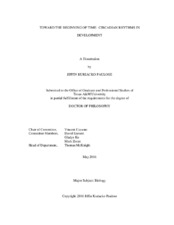| dc.description.abstract | The presence of circadian rhythms during early development has been poorly examined until very recently in vertebrate species. Previous studies have focused on the development of specific structures involved in the control of circadian regulation; however, these structures develop relatively late during development and, in most cases, only mature after parturition. The experiments in this thesis aim to answer the basic question, “When do circadian rhythms first appear?” with a comparative approach utilizing mouse embryonic stem cells in culture and chicken embryos in ovo to 1) establish the first appearance of the full complement of canonical clock genes, 2) analyze the temporal expression patterns at the earliest stages of development, and 3) determine whether external cues can induce a functional molecular clockwork in these tissues. The role of pineal melatonin in regulating circadian rhythms of developing astrocytes is also investigated. The results of these studies show that, while the putative molecular clock is not functional in undifferentiated embryonic stem cells, a physiological rhythm of glucose utilization is present. This metabolic rhythm is amplified upon non-specific differentiation, at which point the molecular clock also starts. In contrast, circadian rhythms of chick embryos in ovo do not appear spontaneously, although all components of the molecular machinery are expressed. The clock in early chick embryos can be driven by – but not entrained to – temperature cycles, but is not responsive to light cycles. Finally, some clock gene rhythms can be driven by rhythmic melatonin signals; however, glucose utilization is fully entrained after several days of rhythmic exposure. Remarkably, pineal melatonin increases mitotic activity in these cells in a dose-dependent fashion, suggesting an auxiliary role of melatonin in embryonic development. While these studies show the earliest observed circadian rhythms in both mammalian and avian model systems, they also show that metabolic rhythms precede those of the molecular mechanism and provide compelling evidence that the ontogeny of circadian time-keeping lies outside of the canonical molecular clockworks. | en |


